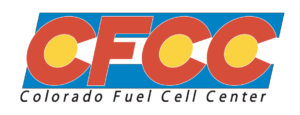Next Gen Renewable Energy Storage
Overview
The Colorado Fuel Cell Center (CFCC) at the Colorado School of Mines develops electrochemical devices to tackle the nation’s needs in electricity generation and energy storage. Among the devices researched are fuel cells, which can be thought of as a battery that can be refueled to prolong its operation period. Fuel cells produced by the CFCC are not performing as anticipated and generally have shorter lives than they should have. The cause behind this underperformance is defined by researchers to be poor adherence between the cathode layer and the electrolyte layer beneath it. Therefore, the CFCC researchers require a quantitative method to measure the force of adhesion between said layers in order to develop more consistent fuel cells.

Hence, senior design team F20-55 was tasked with designing and building a tensile testing device customized to work with fuel cells. The device must strictly apply an axial force on the cathode of the fuel cell, record the force at failure, and generate a force versus time plot. The process of designing this device along with overcoming the accompanying challenges are discussed thoroughly in the following sections of this report.
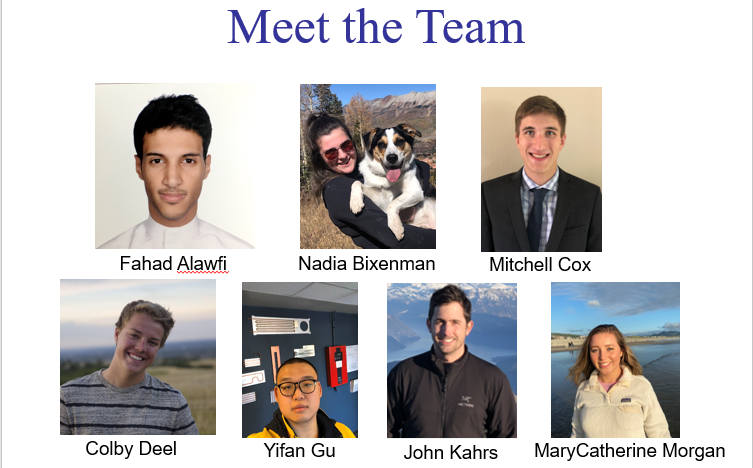
Live Zoom Chat
Time: Apr 29, 2021 08:00 AM Mountain Time (US and Canada)
Join from PC, Mac, Linux, iOS or Android: https://mines.zoom.us/j/8484739887?pwd=Q1R1d2gvZy95VStsTUdzV2dkcVN2dz09
Password: EDNS492
Or iPhone one-tap: 12532158782,8484739887# or 13462487799,8484739887#
Dial: +1 253 215 8782 (US Toll) or +1 346 248 7799 (US Toll)
Meeting ID: 848 473 9887
International numbers available: https://mines.zoom.us/u/ac4GMkvndk
H.323: 162.255.37.11 (US West) or 162.255.36.11 (US East)
Meeting ID: 848 473 9887
Password: 6648426
Password: 6648426
Team Members
- Fahad Alawfi
- Nadia Bixenman
- Mitchell Cox
- Colby Deel
- Yifan Gu
- John Kahrs
- MaryCatherine Morgan
The Client
- Neal Sullivan
Acknowledgements
Project Advisor: Dr. Abd Arkadan
Technical Advisor: Dr. Neal Sullivan
Technical Advisor: Dr. Jim Wong
Video
Elevator Pitch
The project began in August of 2020 with guidance from the head of the CFCC (Dr. Sullivan). Dr. Sullivan wanted a Senior Design team to design, build, and test a device that would accurately measure the force needed to break the mechanical adhesion within the fuel cells his lab produces. The first thing that Team 55 did was to try and locate the inherent challenges in this project. While there were all the typical Senior Design challenges: short timeline, low Budget, part-time work, etc. there were a few challenges that were unique to this project. The first was that this project would be one of the first of its kind. This meant that there was little to no access to successful versions of the test device for the team to examine, so the team was forced to begin the design process at square one. Another unique obstacle the team faced was properly defining the problem. The CFCC knew that they were having adherence issues, but they did not know what was causing the lack of adherence, or the range of forces that a good well-adhered cell would have in comparison to a poorly adhered cell. This leads to the last obstacle the team was faced with. The actual testing of fuel cells would be extremely limited due to the high monetary and time costs associated with making the cells. With these challenges in mind, the team set out to design a device that exceeded the client’s requirements.
Design Approach
Client Requirement
- Computer Interface: Testing Machine shall export the stress/strain curve to a computer and show the current and peak tensile force on the screen.
- Force Isolation: Testing Machine shall exert strictly axial loads on the test specimens.
- Footprint: Testing Machine shall have a footprint that fits laboratory space.
- Force Magnitude: Testing Machine shall accurately measure force loads.
- Precision: Testing Machine shall be able to make repeatable, accurate, and precise measurements of the fuel cell bond’s tensile strength.
- Time: The test machine shall be fully functioning by May 2021.
- User Interface: The test machine shall have accompanying instructions, and be sufficiently simple, such that a novice could correctly run the machine without needing specialized training.
Engineering Analysis
The solid-body finite element analysis was completed assuming the bottom surface of the test stand was fixed, with the load applied upward from the bottom strut, a load applied in the downward direction from the top strut, and the acceleration of gravity applied in the downward direction. Shows in the figure right. Both force magnitudes were 220 Newtons which is the max force that can be applied by the linear actuator. The material used is ASTM A1011 Stainless Steel. This analysis resulted in a minimum factor of safety of 275. This FOS is more than acceptable for the predicted loading of this stand.
To verify FEA results a simplified FEA model was made that tested the top strut as a beam and not a solid body. Shows in the figure right. This beam was fixed on either end with a load of 220 Newtons applied in the middle of the beam. This resembles the hand calculations described below. This model resulted in a minimum factor of safety of 161.2 which is also more than acceptable.
Work Breakdown Structure
The WBS has been refined to a final form seen in the Figure below. The version displayed below defines the major steps and requirements needed to finish this project. Each step helped with organizing team efforts and resources. Moreover, they serve as a reminder of things that need to be done before investigating other aspects of the project. This version can also function as a checklist after finishing the device to ensure that all the goals of this project have been met. The simple and accessible design enabled team members to easily review or adjust the WBS if needed.
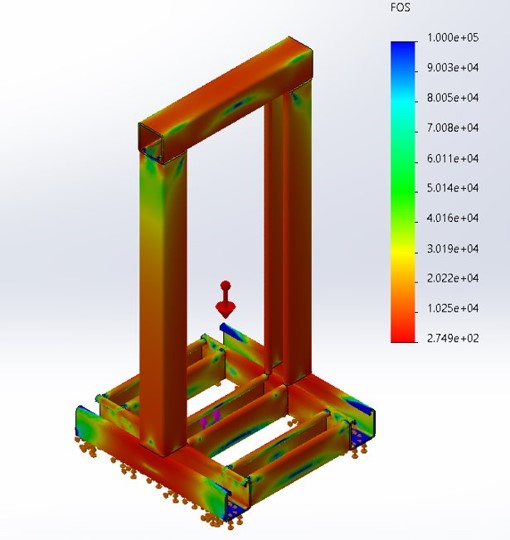
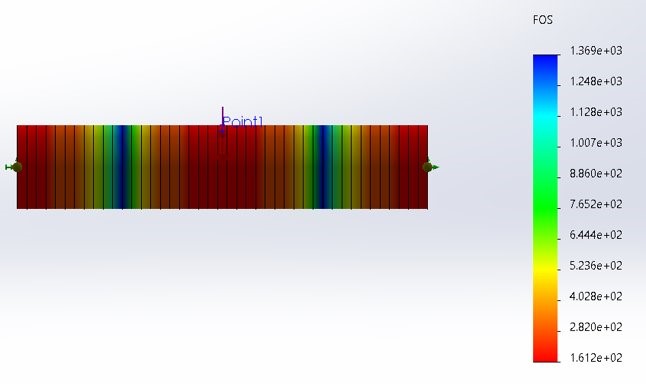
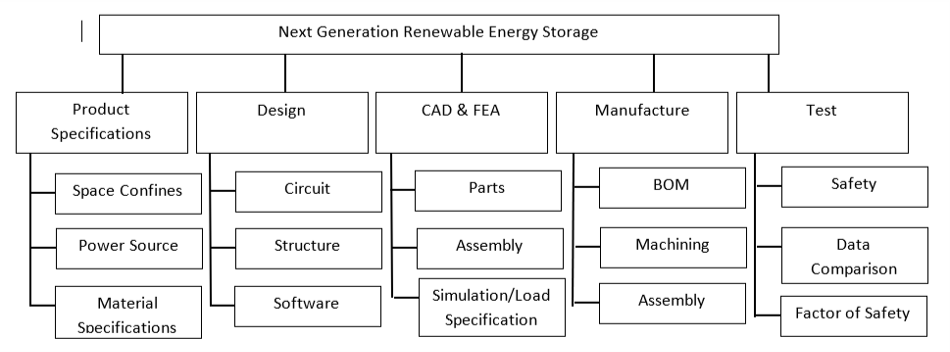
Design Solution
The solution presented by our team is to design and build a tensile testing machine customized for use on fuel cells in order to quantify the adherence between the cathode and the ceramic layer. This will help researchers determine optimal adherence levels to increase the performance and durability of fuel cells.
Frame
The team initially wanted to use 80/20 aluminum extrusion to build the frame, but at the client’s request, Unistrut was used because it was readily available at the CFCC laboratory. Once the material was chosen at the beginning of the second semester, a frame was constructed using hardware found at the CFCC and Unistrut. All cutting of the Unistrut was done in the Mines mechanical engineering machine shop. During construction, it was found that it was difficult to make the frame perfectly square and level during assembly, so leveling feet were added to the design to compensate. Once the frame was complete, the team turned its attention to the electrical components.
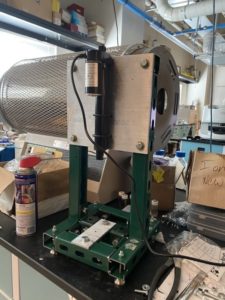

electrical part
The electrical part of the project presented many new challenges to the team. The CFCC already owned a linear actuator for the team to use. However, during early testing, it was discovered that the linear actuator had been broken previously and would not be useable for this project. The team then decided to order a simpler, less sophisticated linear actuator to make interfacing the linear actuator easier. This linear actuator came with mounting brackets, but they would not work for the team’s purposes. Therefore, a custom bracket had to be designed and built to accommodate the new linear actuator. However, this was not the only hardware that needed to be manufactured. The clamp, mentioned previously, along with the plunger to adhere to the fuel cell were also machined. While part of the team worked on machining these components in the machine shop, the other half worked in the CFCC lab on completing the software and electrical systems.
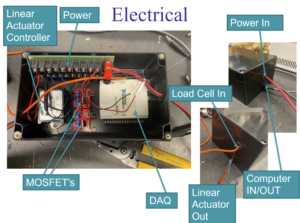
Software
The software, which was written in LabView, was completed quickly as team members had prior experience in load cell instrumentation. The team also had Buddy Haun check and sign off on the LabView program to verify that it would work as intended. Once the software was completed, attention could be turned to electrical. Initially, two 5-volt relays were used to trigger the linear actuator controller. However, through testing, it was determined that the output current of the DAQ was too low to be able to trigger the mechanical relay. The solution to this was to use a MOSFET instead of a relay because MOSFETs have a lower activation current. Once this switch was made the electrical system was finalized quickly. By the time the electrical system was completed, the other half of the team had finished manufacturing the hardware. With all the necessary pieces the, complete assembly was finalized.
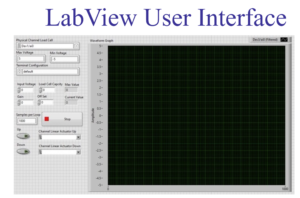
Next Steps
Although our solution has been completed, we still need to improve the details and then test to ensure that this solution can meet the requirements of the CFCC. The following is our next plan.
- Get D-ring to fit into the linear actuator to eliminate the wire or 3D print an attachment piece
- Test with different springs to determine the best combination
- Test with a real, unbroken fuel cell
- Make final decision on epoxy to be used
- Finalize detailed user guide
Meet the Team
Fahad Alawfi

Nadia Bixenman
 Nadia Bixenman is a senior majoring in Mechanical Engineering and graduating in May. She is originally from Houston, Texas but has enjoyed living in Colorado for the past four years. After graduation, she is looking forward to moving out to Oregon to begin a Software Engineering job.
Nadia Bixenman is a senior majoring in Mechanical Engineering and graduating in May. She is originally from Houston, Texas but has enjoyed living in Colorado for the past four years. After graduation, she is looking forward to moving out to Oregon to begin a Software Engineering job.
Mitchell Cox
 Mitch is a Mechanical engineering student that will be graduating in May. He plays on the club ice hockey team at mines and enjoys riding dirt bikes and working on cars.
Mitch is a Mechanical engineering student that will be graduating in May. He plays on the club ice hockey team at mines and enjoys riding dirt bikes and working on cars.
Colby Deel
 Colby Deel is from Lone Tree, Colorado. He is a Mechanical Engineering Major graduating to work in the aerospace industry. In his free time, he enjoys camping, off-roading, and skiing.
Colby Deel is from Lone Tree, Colorado. He is a Mechanical Engineering Major graduating to work in the aerospace industry. In his free time, he enjoys camping, off-roading, and skiing.
Yifan Gu
 Yifan Gu is a B.S. student in Mechanical Engineering. He will be a P.hD. student this summer, 2021. During the free time, he enjoys reading and playing basketball.
Yifan Gu is a B.S. student in Mechanical Engineering. He will be a P.hD. student this summer, 2021. During the free time, he enjoys reading and playing basketball.
John Kahrs
 John-Michael Kahrs will complete his B.S. in Mechanical Engineering this May. He has accepted a job as a Systems Engineer for Lockheed Martin’s Space division in Boulder Colorado. He enjoys spending time with his wife and daughter as well as skiing and trail running.
John-Michael Kahrs will complete his B.S. in Mechanical Engineering this May. He has accepted a job as a Systems Engineer for Lockheed Martin’s Space division in Boulder Colorado. He enjoys spending time with his wife and daughter as well as skiing and trail running.
MaryCatherine Morgan
 MaryCatherine is a 4th-year student studying mechanical engineering with a minor in energy. She is graduating in December 2021 after she studies abroad in Dublin, Ireland to finish her last few classes. This summer she is excited to be interning for Tesla in Austin, TX. She enjoys being outdoors, traveling, and spending time with her friends.
MaryCatherine is a 4th-year student studying mechanical engineering with a minor in energy. She is graduating in December 2021 after she studies abroad in Dublin, Ireland to finish her last few classes. This summer she is excited to be interning for Tesla in Austin, TX. She enjoys being outdoors, traveling, and spending time with her friends.
